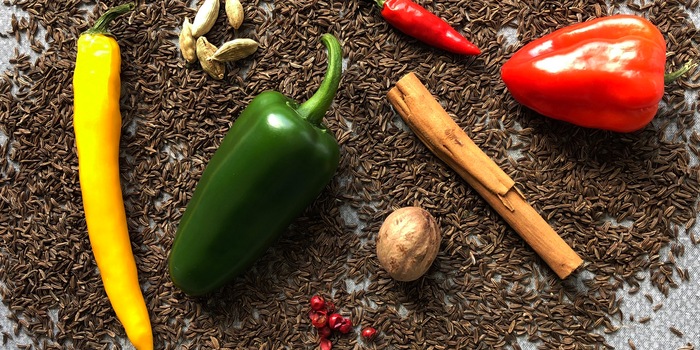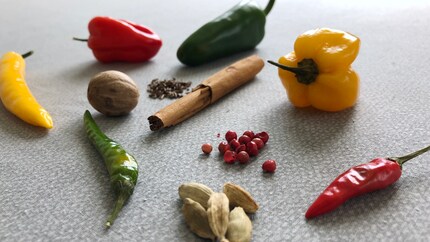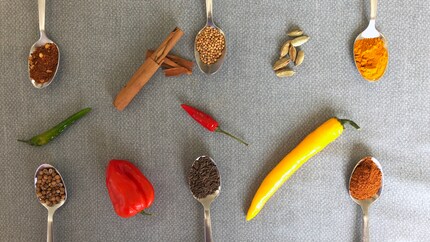

Beyond Aromat: getting your spicy fix in the country of cheese
My first memory of hot food involves my parents’ encounter with some fiery bunny chows. We were in the South African city of Durban in the mid-90s on a beach holiday. As recent new arrivals to the country, they had decided to try out this iconic dish.
Bunny chow features neither rabbit meat nor rabbit food and is essentially a curry served in a hollowed-out loaf of bread. I remember their sweating, flushed faces as they bravely tried to force down a few bites while their eyes watered. Being barely school-age, I was quite horrified and avoided «burny» food for a while. Fortunately, this fear didn’t last. In fact, as I became older, I developed quite a taste for it.
Blistering torment vs thrilling prickle
One theory is that eating more spicy food trains the eater to build up a tolerance for it, which I believe applies to me. I spent my first few years in Switzerland enjoying creamy, moreish-yet-somewhat-bland food before moving to South Africa (SA). That country’s diverse peoples celebrate dishes that are heavily influenced by Indian and Malay flavours.

Interestingly, according to the brand itself, Aromat is the most popular seasoning in SA. It was already well established in the region when my folks arrived about 30 years ago. According to anecdotal evidence, it first appeared on supermarket shelves in the ‘80s. The Aromat South Africa Facebook page has over 100’000 ardent followers. For those wondering, I can attest that the Swiss and South African versions taste the same. One difference is the volume of the product: the SA version is sold in a «canister» of 75g rather than 90g and refills are only available in 450g compared to Switzerland’s hefty 1kg pack.
«Hot» is relative
Both Swiss and South Africans are massive fans of the yellow seasoning, but this is where the similarities regarding flavouring end. This is already obvious when you visit restaurants in either country: ask for condiments in virtually any South African establishment and they’ll bring at least one type of chili sauce. Nando’s – a grilled chicken restaurant chain you may be familiar with – originated in that country. It features a «peri-ometer» with six levels of spiciness ranging from «tangy tomato» to «xtra hot».

Don’t get me wrong, I truly do miss eating out, but one thing did bother me in many a Swiss restaurant in the Before Times: even in Indian and Thai eateries, their approach to spiciness tends to be very careful. Although I can absolutely understand that chefs adapt their recipes to the sensitive palates of the locals, it’s still taking a bit of getting used to. In South Africa, most Indian restaurants, like Nando’s, also give you the option to pick your preferred level of heat. I’ve found that this is often not the case in Switzerland. Even if the dish is labelled as hot, the result is often just a brief, gentle tingle on the tongue.
Anyway, if the menu items appear to be taking the safe route, don’t be shy: ask the staff to turn up the spice level. This may involve a bit of trial and error, requiring more than one visit to the establishment (again, fear of searing a patron’s taste buds may cause a chef to be hesitant, especially if said patron is of the lighter-skinned variety). Don’t give up: eventually you’ll be rewarded with a suitably spicy meal.
If you want something done right…
In most South African kitchens, you’ll find a packet of trusty Rajah-brand curry powder, while some families make their own spice blends. Meanwhile, in Switzerland, there’s often an emphasis on herbs – the leaves of the plant, often dried, which infuse a far more subtle flavour than spices. These include roots, bark and seeds, and pack a far stronger punch. Aside from ginger and chili, they generally aren’t hot either, so there’s something for everyone.

If you have Southeast-Asian roots, you’ll know that cinnamon and star anise can also be used in savoury dishes, but in Europe these have been relegated to the likes of mulled wine and cough syrup.
Since the pandemic started, I, along with many others, have been experimenting with new recipes and making some old favourites. I enjoy trying out different cuisines, and I’m always looking to expand my collection of spices. Fortunately, many are available in the local supermarkets.
And on that note, just a warning: the German «Kümmel» is not cumin, but caraway, which looks virtually the same. Caraway can be found in Basler Fastenwähe, Sauerkraut, goulash and salty Apéro snacks, among others. The spice you’re looking for is «Kreuzkümmel» or «Cumin du Maroc», which is vital to the flavour profile of many Middle Eastern, Mexican, Indian and Turkish dishes.
Once you’ve raided the supermarket, you can start tracking down some of the less-well-known spice and chili varieties. Examples would include black cardamom, amchur, asafoetida or chipotle pepper. You’ll find them in the Asian, Middle Eastern and South American grocers that dot the country (and the web). As for fresh chili peppers, well, you can also always grow your own…
Revisiting the bunny
In part because I was writing this article and in part because I was feeling a little homesick, I decided to make a bunny chow recently. There are many recipes online, but I opted for simple one provided by a wonderful user on The Great Big Saffa Cookbook Facebook group.

A trickier ingredient to figure out was what is called sugar beans in SA. After falling down a rabbit hole of bean naming conventions – many seem to be known by at least three different names – I think they are what is also known as borlotti/cranberry/roman beans. In my opinion, you can substitute them for a mild-tasting variant like cannellini or, in my case, white Soisson beans.

The bread, weirdly enough, also posed a challenge. Typically, you would use affordable white bread that has an even rectangular shape. In Switzerland, the closest variant is «toast bread» but the issue here is that it comes pre-sliced. This is problematic since one needs to hollow out the loaf, so I just opted for a plain white bread.
The final result was highly satisfying with just the right amount of heat thanks to the addition of the chili. As the original inventors of the dish no doubt intended, the simple yet effective blend of spices elevated the neutrally flavoured beans and carbs. As my vegetarian self understands it, meat-filled bunnies are equally delicious.

Like Jess and Eva determined with their fry-up experiment, I can also confirm that you can replicate dishes from abroad in Switzerland. And even if hot food isn’t your thing, anyone can benefit from exploring another culture’s cuisine. Trying something new and colourful keeps life interesting and maybe you’ll even find another recipe to add to your repertoire!
So, do you have a dish from «back home» that you cook when nostalgia hits? Where do you get your rarer spices? What’s your take on Aromat? Let me know below!
For most of my life, I was among the 2% of Swiss abroad who live in Africa. I still rarely carry cash on me, a habit I’m trying to break as it can result in very awkward situations. Like when trying to settle a bill in a remote mountain-top restaurant. My dream job is to be a forest sprite – since this is rather unattainable, I instead spend a lot of my free time birding or running in the woods.
Interesting facts about products, behind-the-scenes looks at manufacturers and deep-dives on interesting people.
Show all